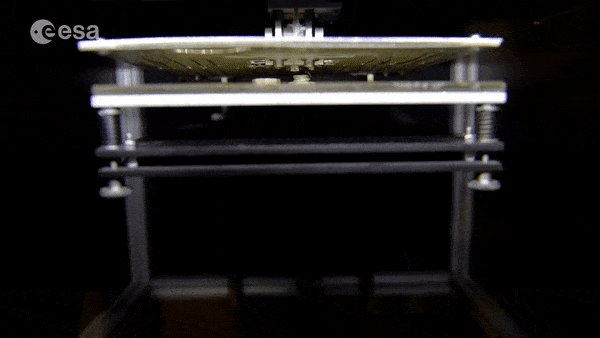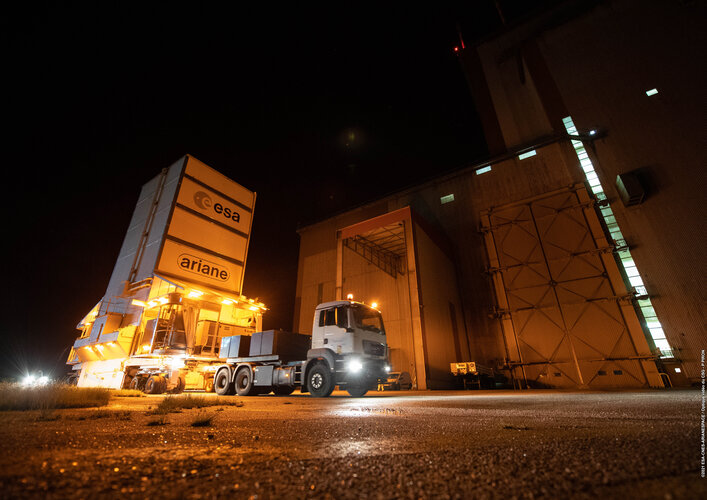
Copernical Team
Chinese astronauts give science lesson from space station

Chinese astronauts on Thursday beamed back a science lesson from the country's under-construction space station.
The lecture focused on physics, aiming to illustrate how the weightless environment affects buoyancy, the movement of objects and optics.
Join our online ESA-NASA Advanced Manufacturing conference

Next year’s 1st International Conference on Advanced Manufacturing for Air, Space and Land Transportation, co-organised by ESA and NASA, is moving online.
Webb moved to meet Ariane 5
 Image:
Image:
The James Webb Space Telescope was transferred to the final assembly building at Europe’s Spaceport in French Guiana on 7 December 2021, to meet its Ariane 5 launch vehicle.
Stowed inside a special 23-tonne transport container, Webb was protected and monitored throughout the transfer.
Ariane 5 was already moved to the same building on 29 November. Here, adjustable platforms allow engineers to access the launch vehicle and its payload.
The next steps are to hoist Webb to the upper platform which has been prepared so that Webb can be integrated on Ariane 5’s upper stage and then encapsulated inside
China's lunar rover spots cube-like object on Moon, sparking curiosity
 The cube-like object spotted recently by China's lunar rover on the far side of the moon aroused wild curiosity in cyberspace worldwide this week.
Yutu 2, the lander and rover of the Chang'e 4 probe, captured an obscure but intriguing image about 80 meters from its location during the mission's 36th lunar day, according to Our Space, a Chinese science channel that published the machine's l
The cube-like object spotted recently by China's lunar rover on the far side of the moon aroused wild curiosity in cyberspace worldwide this week.
Yutu 2, the lander and rover of the Chang'e 4 probe, captured an obscure but intriguing image about 80 meters from its location during the mission's 36th lunar day, according to Our Space, a Chinese science channel that published the machine's l NASA Returns Hubble to Full Science Operations
 NASA's Hubble Space Telescope team recovered the Space Telescope Imaging Spectrograph on Monday, Dec. 6, and is now operating with all four active instruments collecting science. The team has still not detected any further synchronization message issues since monitoring began Nov. 1.
The team will continue work on developing and testing changes to instrument software that would allow them
NASA's Hubble Space Telescope team recovered the Space Telescope Imaging Spectrograph on Monday, Dec. 6, and is now operating with all four active instruments collecting science. The team has still not detected any further synchronization message issues since monitoring began Nov. 1.
The team will continue work on developing and testing changes to instrument software that would allow them LCO Scientists Confirm the Discovery of the First Moving Microlensing Arcs
 On April 18, 2019, the European Space Agency's Gaia Mission alerted astronomers worldwide to an unusually bright but fleeting celestial event: the gravitational microlensing event Gaia19bld. The temporary, chance alignment between two unrelated star systems produced twin images of the background star and gave scientists their first opportunity to actually observe the arc-shaped images move in re
On April 18, 2019, the European Space Agency's Gaia Mission alerted astronomers worldwide to an unusually bright but fleeting celestial event: the gravitational microlensing event Gaia19bld. The temporary, chance alignment between two unrelated star systems produced twin images of the background star and gave scientists their first opportunity to actually observe the arc-shaped images move in re First crew of space station provide a full update on China's progress
 The three astronauts involved in the Shenzhou XII mission have recovered well after their 3-month spaceflight and will return to regular training once related health assessments are completed.
Major General Jing Haipeng, another astronaut, said on Tuesday the post-spaceflight recovery period has three phases: isolation, convalescence and observation.
The three Shenzhou XII astronauts
The three astronauts involved in the Shenzhou XII mission have recovered well after their 3-month spaceflight and will return to regular training once related health assessments are completed.
Major General Jing Haipeng, another astronaut, said on Tuesday the post-spaceflight recovery period has three phases: isolation, convalescence and observation.
The three Shenzhou XII astronauts US Army tests multi-orbit solutions leveraging MEO capabilities amid SES's upcoming O3b mPOWER launch
 SES Government Solutions (SES GS), a wholly-owned subsidiary of SES, supports the U.S. Army in conducting a series of cutting-edge trials and testing of commercial satellite constellations in multiple orbits, as well as services and ground terminals, in the U.S. Government's effort to establish Multi-Domain Operations (MDO) by 2028.
Most recently, the U.S. Army announced its integrated gro
SES Government Solutions (SES GS), a wholly-owned subsidiary of SES, supports the U.S. Army in conducting a series of cutting-edge trials and testing of commercial satellite constellations in multiple orbits, as well as services and ground terminals, in the U.S. Government's effort to establish Multi-Domain Operations (MDO) by 2028.
Most recently, the U.S. Army announced its integrated gro Space Force mission blasts off from Florida after multiple delays
 A mission overseen by the U.S. Space Force to send equipment into space aboard an Atlas V rocket lifted off from Florida early Tuesday after a delay of several days.
United Launch Alliance sent the Space Test Program-3 (STP-3) mission into space from Launch Complex 41 at the Cape Canaveral Space Force Station in Florida at about 5:19 a.m. EST Tuesday.
The mission lifted off carry
A mission overseen by the U.S. Space Force to send equipment into space aboard an Atlas V rocket lifted off from Florida early Tuesday after a delay of several days.
United Launch Alliance sent the Space Test Program-3 (STP-3) mission into space from Launch Complex 41 at the Cape Canaveral Space Force Station in Florida at about 5:19 a.m. EST Tuesday.
The mission lifted off carry Oculus Observatory set to disrupt space situational awareness globally
 The 'Oculus Observatory' is a new kind of space observatory, designed, built, and managed by Silentium Defence, which delivers the widest field of view, and the most cost-effective monitoring of objects in orbit, anywhere in the world.
Opened today, by Head of the Australian Space Agency, Enrico Palermo, 'Oculus' is located on the fringe of South Australia's dark sky reserve in the Mid-Mur
The 'Oculus Observatory' is a new kind of space observatory, designed, built, and managed by Silentium Defence, which delivers the widest field of view, and the most cost-effective monitoring of objects in orbit, anywhere in the world.
Opened today, by Head of the Australian Space Agency, Enrico Palermo, 'Oculus' is located on the fringe of South Australia's dark sky reserve in the Mid-Mur 
































